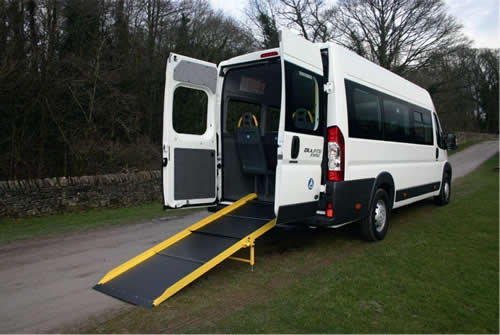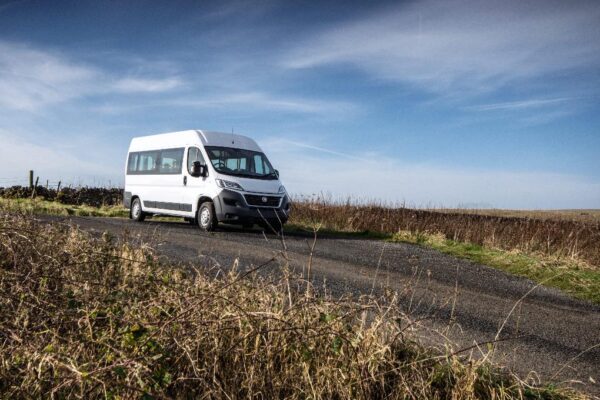This section explores the benefits and drawbacks of ramps versus tail lifts, the main subtypes of each, the situations when one might be more suitable than the other and the factors to consider when selecting from the available options.

Wheelchair Ramps
If the base vehicle is a front-wheel-drive vehicle with a low loading height, it may be practical to consider a wheelchair ramp.
Please note that manual ramps are not available for wheelchair access on rear-wheel drive vehicles as they do not offer safe access on this vehicle type and do not meet access angles dictated by Type Approval.
The advantages of wheelchair ramps are that they cannot break down as tail lifts might, they are less expensive, and are quicker to use when more than one wheelchair is to be loaded. However, it is important to consider the strength of the attendant and the weight of the occupied wheelchair. An electrically operated winch may be specified to assist with
loading. Wheelchair ramps fold in two and are stowed upright inside the rear doors when not in use. They can feature gas strut assistance, for ease of stowage and deployment. Full width ramp platforms have a non-slip tread.
Lowerable air suspension and ramp
This is available as an option on all Renault, Vauxhall, Ford (FWD models only), Fiat Ducato and Peugeot Boxer vehicles. By operation of a switch from the cab, or from the rear entrance, the rear suspension is lowered to provide a reduced loading
height. The associated ramp is then manually lowered to provide easy wheelchair access.
The main advantage of this system is that the angle of ascent/descent is less than with a standard ramp, but its suitability will still be governed by the strength
of the attendant and the weight of the occupied wheelchair. As an additional benefit, the air suspension will provide improved road holding, and passengers will be afforded a more comfortable ride.

Underfloor Lifts
Where the base vehicle design allows, an underfloor tail lift can be fitted.
Some models dictate an extended rear bumper to accommodate the lift.
When not in use, the electro-hydraulic tail lift is stowed within a fully enclosed cassette, to the vehicle underside.
All feature a non-slip platform, toe guard/bridge plate, automatic roll off prevention bar, twin handrails and an auxiliary hand pump.
Underfloor or ‘cassette’ tail lifts are available from a number of manufacturers. All lifts are available with a range of different platform sizes though the largest platforms will not suit all models. M2 Type Approval dictates a minimum platform size of 800mm wide, 1200mm long. Tail lifts generally offer capacities of 300kgs, 350kgs and 400kgs SWL, although heavier Bariatric models are available tested up to 500kgs. Tail lifts must be checked every six months and weight tested every year in accordance with LOLER regulations.

Internal Lifts
For many vehicles, an internal electro-hydraulic tail lift will be the best option.
There are a number of platform designs. Some platforms split as they fold away, to provide a passageway through the back doors. Another design folds in half within its length so that it does not block the view through the rear door windows. Some platforms do not split or fold and simply stand upright inside the rear doors when stowed.
Internal electro-hydraulic tail lifts are all automatic in operation. This automatic function allows deployment and stowing of the lift platform from a remote wander lead handset. This same hand set also controls the raising and lowering of the platform in use. The lift is stowed upright inside the rear doors, when not in use.
Internal lifts occupy some 18” to 20” (450mm to 500mm) of saloon space and as such must be allowed for when the seat plan is created. Internal lift platforms are available in a wide range of sizes. It is important to assess the size of wheelchairs to be loaded. If the attendant is to travel on the platform, standing behind the wheelchair, then this must also be taken into account.









